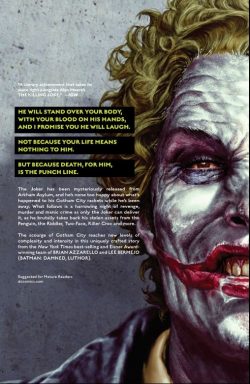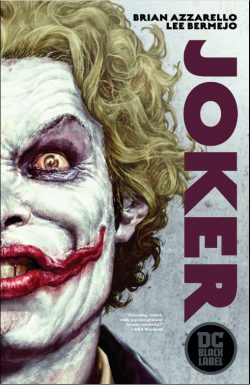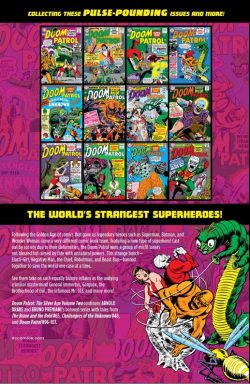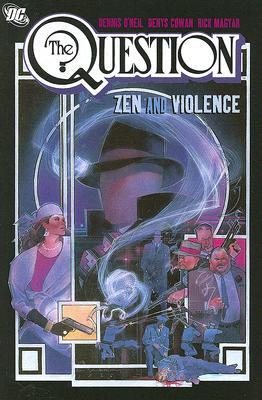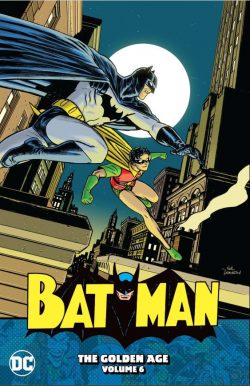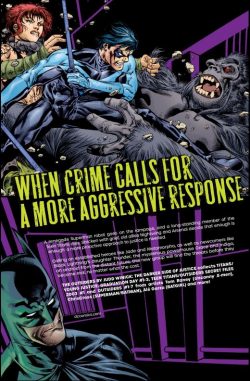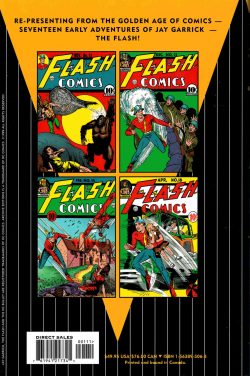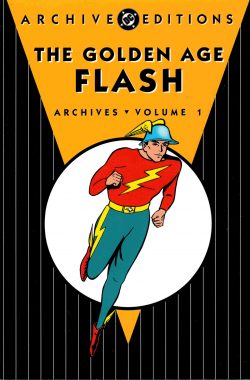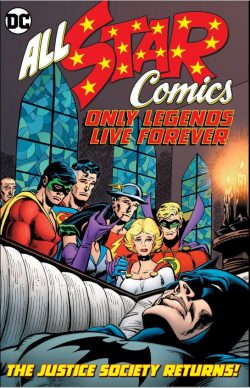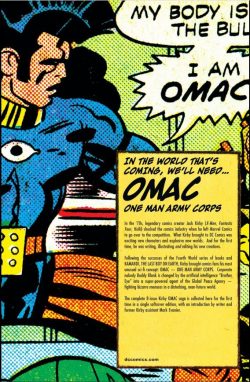
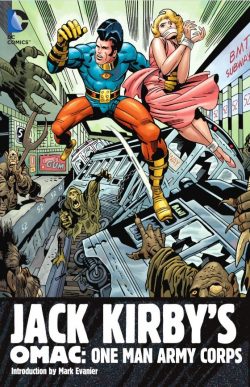
By Jack Kirby with D. Bruce Berry, Mike Royer & various (DC)
ISBN: 978-1-4012-1790-7 (HB) 978-1-4012-4042-4 (TPB)
Win’s Christmas Gift Recommendation: A Terrifying Timeless Blockbuster… 9/10
There’s a magnificent abundance of Jack Kirby collections around these days – ‘though still not everything, so I’ve still got reason to carp. This slim hardback, trade paperback or digital collection re-presents possibly his boldest and most heartfelt creation after the comics landmark that was his Fourth World Cycle.
Famed for his larger than life characters and gigantic, cosmic imaginings, “King†Kirby was an astute, spiritual man who had lived through poverty, gangsterism, the Depression and World War II. He had seen Post-War optimism, Cold War paranoia, political cynicism and the birth and death of peace-seeking counter-cultures. He always looked to the future and he knew human nature intimately. In OMAC: One Man Army Corps, he let his darkest assumptions and prognostications have free rein, and his “World That’s Coming†was far too close to the World we’re frantically trying to escape now…
In 1974, with his newest creations inexplicably tanking at DC, Kirby tentatively considered a return to Marvel, but – ever the consummate professional – he scrupulously carried out every detail of his draconian DC contract. When The Demon was cancelled, the King needed to find another title to maintain his Herculean commitments (Jack was legally obliged to deliver 15 completed pages of art and story per week!) and returned to an idea he had shelved in 1968.
That was to re-interpret Captain America into a possible future where all Kirby’s direst prognostications and fears could be made manifest. In 1974 he revisited those worries and produced a nightmare scenario that demanded not a hero but a warrior.
Dubbing his Day-After-Tomorrow dystopia “The World That’s Comingâ€, Kirby let his mind run free – and scared – to birth a frighteningly close appreciation of our now, where science and wealth have outstripped compassion and reason, and humanity teeters on the brink of self-inflicted global destruction.
OMAC #1 launched in September-October 1974, introducing the Global Peace Agency, a world-wide Doomwatch police force who manufactured a super-soldier to crisis-manage the constant threats to a species with hair-trigger fingers on nuclear stockpiles, chemical weapons of mass destruction and made-to-measure biological horrors.
Base human nature was the true threat behind this series, and that was first demonstrated by decent young man Buddy Blank who, whilst working at Pseudo-People Inc., discovers that the euphemistically entitled Build-A-Friend division hides a far darker secret than merely pliant girls that come in kit-form. (I think we even have those now, too…)
Luckily Buddy has been singled out by the GPA’s resident genius Professor Myron Forest for eternal linkage to sentient satellite Brother Eye. His atoms shifted and reconstructed, Buddy is rebuilt until he becomes a living God of War, and the new-born human weapon easily destroys his ruthless employers before their murderous plans can be fully realised. ‘Buddy Blank and Brother Eye’ was followed by a truly prophetic tale, wherein impossibly wealthy criminal Mister Bigpurchases an entire city simply to assassinate Professor Forest in ‘The Era of the Super-Rich!’
Kirby’s tried and trusted approach was always to pepper high concepts throughout blazing action, and #3 was the most spectacular yet. OMAC fought ‘One Hundred Thousand Foes!’ to get to murderous Marshal Kafka; terrorist leader of a Rogue-State with a private army, WMDs and a solid belief that the United Nations can’t touch him. Sound familiar…?
That incredible clash carries on and concludes in #4’s ‘Busting of a Conqueror!’ With #5, Kirby moved on to other new crimes for a new world. The definition of a criminal tends to blur when you can buy anything – even justice – but rich old people cherry-picking young men and women for brain-implantation is (hopefully) always going to be a no-no. Still, you can sell or plunder specific organs even now…
Busting the ‘New Bodies for Old!! Â racket took two issues, and after the One-Man-Army-Corps smashed ‘The Body Bank!’ he embarked on his final adventure. Ecological disaster and water shortage is the theme of the last tale, but as our hero trudges across a dry and desolate lake bottom amidst the dead and dying marine life he is horrified to discover the disaster to be the work of one man. ‘The Ocean Stealers!’ (#7) introduces Doctor Skuba, a scientific madman who mastered the very atomic manipulation techniques that had turned feeble Buddy Blank into an unstoppable war machine.
Joe Kubert drew the cover to OMAC #8 ‘Human Genius Vs Thinking Machine’; an epic episode seeing Brother Eye apparently destroyed as Skuba and Buddy Blank die together in an incredible explosion.
But that final panel is a hasty, last-minute addition by unknown editorial hands, for the saga never actually finished. Kirby, his contract completed, had promptly returned to Marvel and new challenges such as Black Panther, Captain America, 2001, Devil Dinosaur, Machine Man and especially The Eternals.
Hormone treatments, Virtual Reality, medical computers, satellite surveillance, genetic tampering and all the other hard-science predictions in OMAC pale into insignificance against Kirby’s terrifyingly accurate social observations in this bombastic and tragically incomplete masterpiece.
OMAC is Jack Kirby’s Edwin Drood, an unfinished symphony of such power and prophecy that it informs not just the entire modern DC universe and inspires ever more incisive and intriguing tales from the King’s artistic inheritors but still presages more truly scary developments in our own mundane and inescapable reality…
As always in these wondrously economical collections it should be noted that the book is also stuffed with un-inked Kirby pencilled pages and roughs, and Mark Evanier’s fascinating, informative introduction is a fact-fan’s delight. Crucially, as ever, Kirby’s words and pictures are an unparalleled, hearts-and-minds grabbing delight no comics  lover could resist.
Jack Kirby is unique and uncompromising. If you’re not a fan or simply not prepared to see for yourself what all the fuss has been about then no words of mine will change your mind. That doesn’t alter the fact that Kirby’s work from 1937 to his death in 1994 shaped the entire American comics scene, affected the lives of billions of readers and thousands of creators in all areas of artistic endeavour around the world for generations and still wins new fans and apostles every day, from the young and naive to the most cerebral of intellectuals. His work is instantly accessible, irresistibly visceral, deceptively deep whilst being simultaneously mythic and human: and just plain Great.
© 1974, 1975, 2009 DC Comics. All Rights Reserved.



